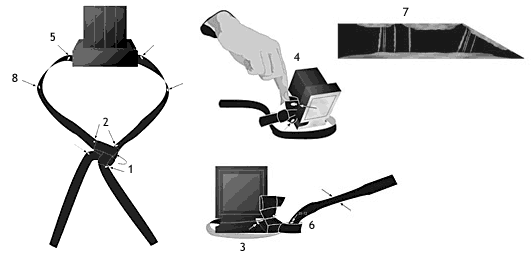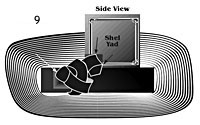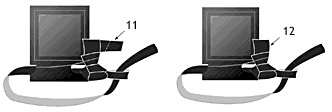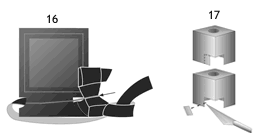|
Bound to the Creator
Rabbi Yerachmiel Askotzky
As Jews, we employ many means to bring ourselves closer to the Almighty. In fact, our purpose in this world is to become as close to Him as possible by sanctifying the mundane through injecting spirituality and G-dliness, into our material existence. To do so we must emulate the Almighty�s codes of ethics and deeds and follow his blueprint for spiritual perfection, the holy Torah. Through the means of our commitment to the Torah and emulation of His ways the closer we become to the Almighty.
One of the ways in which we connect to the creator is by binding the tefillin to our arm and head. Many of us are likely under the impression that the primary components of the tefillin are the batim, leather housings and the parashiot, parchments, while the retzuot, leather straps, are simply means to bind them to our body. However, in some ways the retzuot are more critical than their larger and more costly counterparts. Rather than just being a means to strap the batim and parashiot to the arm and head they are, in fact, an integral part of the mitzvah of tefillin. While we often are careful to purchase quality batim and parashiot and to maintain them we pay little attention to our retzuot other than the fact that they should be soft. Unfortunately, this error is cause for many to either not fulfill the mitzvah of tefillin or at least not fulfill it in its preferable manner. The single most common reason for invalid or non preferable tefillin is due to the retzuot. (This is besides the fact that many halachic authorities do not consider machine made retzuot to be preferably kosher.)
I will present the three most common problems, provide some explanations for the causes and will suggest how to remedy and prevent them.
Problem A:
- Tefillin retzuot must be completely black on the upper surface. Many retzuot lack paint:
- on or near the knots
- along the area which rubs against the batim
- where the retzuah rubs against itself, such as where the retzuah goes through the loop
- near the end where its wrapped around the hand
- By the bends of the head retzuah along which it is folded

Cause A:
- Often the retzuah is not expertly inserted and the upper edges and occasionally the center surface are frayed. Even when it is inserted with proper care the Nusach Sephard knot used by Chassidim and Sepharadim may fray since the entire loop has to be drawn through a tight passageway.
- The retzuah is wrapped too tightly around the arm or the plastic case. While leather naturally contracts and expands to a limited degree, paint does not have this property and will crack.
-
 The retzuah rests too snugly or rubs against the plastic case. This is common with the knot and loop of the arm retzuah. The retzuah rests too snugly or rubs against the plastic case. This is common with the knot and loop of the arm retzuah.
- The retzuah naturally rubs against the bayit and against itself and paint gradually wears off.
- The excess at the end of the arm retzuah is tucked in a few times and often knotted. This regular and significant friction wears off the paint.
- The upper edges are naturally chafed by the hair and skin gradually causing the paint on the very upper edges to wear.
One need not worry that the black is no longer glossy or that some parts are matte and other parts glossy. The gloss is a finish over the paint and will gradually wear with time causing the paint to appear naturally matte.
Solution A:
- Be certain to have an experienced sofer or individual insert the retzuot. He will know how to insert them with minimal or no damage.
- Only wrap the retzuot around the arm and cases tight enough so they will not become loose and no more. Wrap them around the cases in a natural way- don�t force the straps to go at an unnatural angle.
- Have a sofer cut the cases to allow the retzuot to rest within them without being tightly pressed against it. In addition, make sure that when you open the cases they do not catch on the retzuot.
- Regularly look over your retzuot for wearing and cracking. Keep a bottle of special tefillin paint or a marker with you so you can make emergency touch ups at any time. Be certain to say �L�shem kedushat tefillin� prior to beginning to paint.
- Choose a set date each month to thoroughly review your retzuot. This will not require more than 3-4 minutes! If the retzuot require some touching up I suggest you take a few minutes and do it then. If need be write yourself a note so you will remember to deal with it the same day!
- If the end of the arm retzuah is very worn and requires regular painting them it is permitted to cut off the piece and put it in Shaimos, a depository for holy items. Bear in mind this is only if you can still properly wrap the retzuah without this section.
- It is very difficult to maintain the blackness of the upper edges once they wear. You will either need to check them and likely touch them up every few weeks or just have them replaced.
The lifespan of the arm retzuah is 5-10 years while the head retzuah may last up to twice as long. Do not play around with the mitzvah. If the strap requires regular touching up just replace it.
For the sake of simplicity and brevity and because all opinions require that the retzuah be completely black in order to be preferably kosher I have not discussed when the retzuah lacks paint and may still be considered not preferably kosher.
Today almost all retzuah makers are producing �all black� handmade (avodat yad) straps. In addition to being painted on the top, sides and back, the leather is black through and through. Due to the fact that these all black retzuot are comparably priced to the standard handmade retzuot and the sides are black, which is a worthy hiddur (See Keset Hasofer and I have see this in the name of the Vilna Gaon) and basically solves �problem A�, these retzuot are a most worthwhile option.
Problem B:
- The retzuah does not meet the minimal width of 9mm and preferably 10/11mm. Sepharadim, Chabad and those who follow the measurements of Rav Avraham Chaim Naeh may rely on a preferable width of 10mm. There are opinions that even less than 9mm the tefillin may be used if there is no other option.
Cause B:
- The primary cause of the stretching of the retzuah is due to wrapping it too tightly around the arm or the case.
Solution B:
- Only wrap the retzuah around the arm and around the cases tight enough so that it will not become loose. Wrapping the retzuah tightly will gradually cause it to stretch, particularly at the point where it is drawn through the loop of the arm retzuah.
- Choose a retzuah that is not too thin as the thinner it is the quicker it will stretch. A thickness of around 1.5mm is ideal. Bear in mind that a small bayit and a retzuah tied according to nusach Sephard cannot be too thick. You could use a slightly thicker retzuah for the head tefillin on a normal size bayit and for the arm retzuah tied according to nusach Ashkenaz.
- Similarly, a wider retzuah will less easily stretch. When possible, use a 15mm wide retzuah rather than 14mm wide or less. This width may be a bit wide for a small bar mitzvah boy in which case use the 14mm width.
Problem C:
- The leg of the Yud of the knot of the arm retzuah has slipped back so it is completely not visible.
- The leg of the Yud of the knot of the arm retzuah sticks out too far and forms the shape of a Vav.
- The Yud part of the arm retzuah knot came apart and you or a friend thought you knew how to retie it but in fact you tied it incorrectly.
Cause C:
- The Yud part of the knot is loose and does not stay in place even when you pull it out.
- The Yud was tied incorrectly from the outset and has always looked like a Vav or you decided to give the leg a tug and forced it to stick out more so that it now looks like a Vav.
Solution C:
- Have a sofer or one who can confidently make the knot retie the Yud more tightly. Say �Lshem Kedushat tefillin� when redoing it. By doing so, the leg of the Yud may become too long and will need trimming. Alternatively the entire knot can be remade or the slack can be drawn in so there is no excess to require trimming.
- Trim the leg so that it is now a leg of a Yud or retie the knot or draw in the excess.
- Either learn how to correctly tie the knot and confirm it is right from someone who knows or leave it to an expert.
On a related matter, be certain that the Yud of the knot of the arm retzuah rests against the side of the upper cube of the Bayit. It only has to touch even ever so slightly. It must touch while being worn and should also touch when resting in the bag. The Yud will generally touch and stay put when the knot is tied according to nusach Sephard. However, the Yud of the knot tied according to nusach Ashkenaz will most likely require some sort of restraint. Make sure that when you purchase new tefillin or retzuot that it is touching and check it every once in a while.
Additionally, check the batim each month to make sure that they are completely black on all the outer surfaces other than the bottom. The paint on the edges and corners commonly wear and will need occasional maintenance.
Let us bear in mind that just as we would never use a frayed fan belt or tie our boat to the dock with a tattered line or would be embarrassed to be seen with a shabby belt how much more so must we care for our sacred retzuot as through these straps we not only bind them to our arm and head but with the same action we are binding our total beings to the creator!
Rabbi Yerachmiel Askotzky is an experienced sofer STaM, Torah scribe and author of the acclaimed book Tefillin & Mezuzos, a sofer shows you how to choose, maintain and understand your tefillin, mezuzah and Torah scrolls; Targum Press, Jerusalem, 2003. Visit Rabbi Askotzky�s website www.stam.net for educational information, Ask the Sofer service and contact information. Rabbi Askotzky distributes an attractive, full color Proper Tefillin Placement poster free of charge to schools and synagogues.
In order to assist your fellow Jew to fulfill the mitzvah of tefillin, kindly forward this article via any means available to you. Permission is granted to reprint, post on any website or e-mail to any list only if done so in its entirety. You can also link to the article at http://www.stam.net/tefillin_straps.aspx.
|


